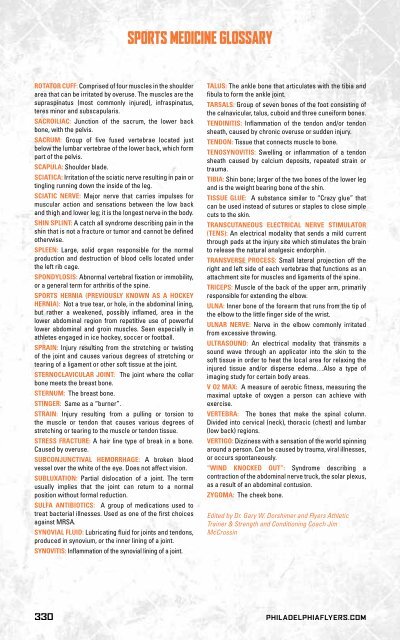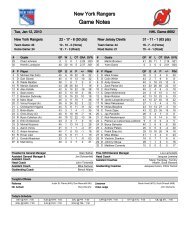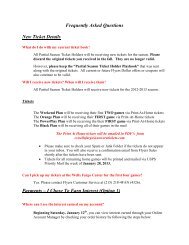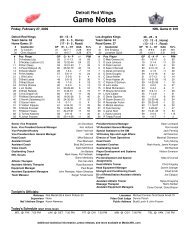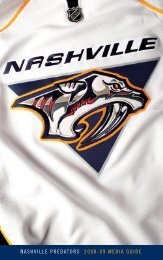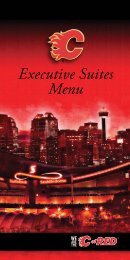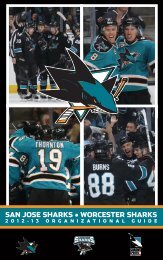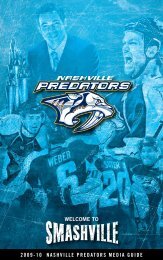flyers media guide - Philadelphia Flyers
flyers media guide - Philadelphia Flyers
flyers media guide - Philadelphia Flyers
You also want an ePaper? Increase the reach of your titles
YUMPU automatically turns print PDFs into web optimized ePapers that Google loves.
Sports medicine Glossary<br />
Rotator Cuff: Comprised of four muscles in the shoulder<br />
area that can be irritated by overuse. The muscles are the<br />
supraspinatus (most commonly injured), infraspinatus,<br />
teres minor and subscapularis.<br />
Sacroiliac: Junction of the sacrum, the lower back<br />
bone, with the pelvis.<br />
Sacrum: Group of five fused vertebrae located just<br />
below the lumbar vertebrae of the lower back, which form<br />
part of the pelvis.<br />
Scapula: Shoulder blade.<br />
Sciatica: Irritation of the sciatic nerve resulting in pain or<br />
tingling running down the inside of the leg.<br />
Sciatic Nerve: Major nerve that carries impulses for<br />
muscular action and sensations between the low back<br />
and thigh and lower leg; it is the longest nerve in the body.<br />
Shin Splint: A catch all syndrome describing pain in the<br />
shin that is not a fracture or tumor and cannot be defined<br />
otherwise.<br />
Spleen: Large, solid organ responsible for the normal<br />
production and destruction of blood cells located under<br />
the left rib cage.<br />
Spondylosis: Abnormal vertebral fixation or immobility,<br />
or a general term for arthritis of the spine.<br />
Sports Hernia (previously known as a hockey<br />
hernia): Not a true tear, or hole, in the abdominal lining,<br />
but rather a weakened, possibly inflamed, area in the<br />
lower abdominal region from repetitive use of powerful<br />
lower abdominal and groin muscles. Seen especially in<br />
athletes engaged in ice hockey, soccer or football.<br />
Sprain: Injury resulting from the stretching or twisting<br />
of the joint and causes various degrees of stretching or<br />
tearing of a ligament or other soft tissue at the joint.<br />
Sternoclavicular joint: The joint where the collar<br />
bone meets the breast bone.<br />
Sternum: The breast bone.<br />
Stinger: Same as a “burner”.<br />
Strain: Injury resulting from a pulling or torsion to<br />
the muscle or tendon that causes various degrees of<br />
stretching or tearing to the muscle or tendon tissue.<br />
Stress Fracture: A hair line type of break in a bone.<br />
Caused by overuse.<br />
Subconjunctival Hemorrhage: A broken blood<br />
vessel over the white of the eye. Does not affect vision.<br />
Subluxation: Partial dislocation of a joint. The term<br />
usually implies that the joint can return to a normal<br />
position without formal reduction.<br />
Sulfa Antibiotics: A group of medications used to<br />
treat bacterial illnesses. Used as one of the first choices<br />
against MRSA.<br />
Synovial Fluid: Lubricating fluid for joints and tendons,<br />
produced in synovium, or the inner lining of a joint.<br />
Synovitis: Inflammation of the synovial lining of a joint.<br />
Talus: The ankle bone that articulates with the tibia and<br />
fibula to form the ankle joint.<br />
Tarsals: Group of seven bones of the foot consisting of<br />
the calnavicular, talus, cuboid and three cuneiform bones.<br />
Tendinitis: Inflammation of the tendon and/or tendon<br />
sheath, caused by chronic overuse or sudden injury.<br />
Tendon: Tissue that connects muscle to bone.<br />
Tenosynovitis: Swelling or inflammation of a tendon<br />
sheath caused by calcium deposits, repeated strain or<br />
trauma.<br />
Tibia: Shin bone; larger of the two bones of the lower leg<br />
and is the weight bearing bone of the shin.<br />
Tissue glue: A substance similar to “Crazy glue” that<br />
can be used instead of sutures or staples to close simple<br />
cuts to the skin.<br />
Transcutaneous Electrical Nerve Stimulator<br />
(TENS): An electrical modality that sends a mild current<br />
through pads at the injury site which stimulates the brain<br />
to release the natural analgesic endorphin.<br />
Transverse Process: Small lateral projection off the<br />
right and left side of each vertebrae that functions as an<br />
attachment site for muscles and ligaments of the spine.<br />
Triceps: Muscle of the back of the upper arm, primarily<br />
responsible for extending the elbow.<br />
Ulna: Inner bone of the forearm that runs from the tip of<br />
the elbow to the little finger side of the wrist.<br />
Ulnar Nerve: Nerve in the elbow commonly irritated<br />
from excessive throwing.<br />
Ultrasound: An electrical modality that transmits a<br />
sound wave through an applicator into the skin to the<br />
soft tissue in order to heat the local area for relaxing the<br />
injured tissue and/or disperse edema…Also a type of<br />
imaging study for certain body areas.<br />
V O2 max: A measure of aerobic fitness, measuring the<br />
maximal uptake of oxygen a person can achieve with<br />
exercise.<br />
Vertebra: The bones that make the spinal column.<br />
Divided into cervical (neck), thoracic (chest) and lumbar<br />
(low back) regions.<br />
Vertigo: Dizziness with a sensation of the world spinning<br />
around a person. Can be caused by trauma, viral illnesses,<br />
or occurs spontaneously.<br />
“Wind Knocked Out”: Syndrome describing a<br />
contraction of the abdominal nerve truck, the solar plexus,<br />
as a result of an abdominal contusion.<br />
Zygoma: The cheek bone.<br />
Edited by Dr. Gary W. Dorshimer and <strong>Flyers</strong> Athletic<br />
Trainer & Strength and Conditioning Coach Jim<br />
McCrossin<br />
330<br />
<strong>Philadelphia</strong><strong>Flyers</strong>.com


